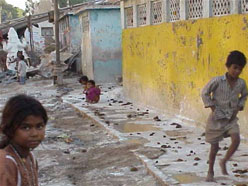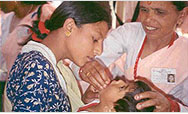International Year of Sanitation (IYS)
On November 21, 2007, the United Nations General Assembly in New York declared 2008 to be the International Year of Sanitation (IYS). The launch was an important event for sanitation advocacy.
 |
| |
Children in an Ahmedabad, India slum. Poor sanitation is a major cause for lost school days because of illness. Girls in particular miss out on educational opportunities because of the lack of clean and safe latrines in schools.
Source: John Borrazzo/USAID |
Imagine life without a toilet. No toilets in your home or at work, no public toilets, no toilets anywhere. This is the daily reality for 2.6 billion people – 40 percent of the world's population.
Lack of access to sanitation is especially difficult for children who pay the price in lost lives, missed schooling, in disease, and malnutrition. Inadequate sanitation, poor hygiene, and unsafe water claim the lives of an estimated 1.6 million children under the age of 5 every year.
Sanitation – think about it next time you flush.
For more information on sanitation, including ways in which you can help, please go to http://ehproject.org and http://esa.un.org/iys/.
Key Facts
- 2.6 billion people do not have somewhere safe, private, and hygienic to go to the toilet.
- Safe disposal of feces leads to a one-third reduction in childhood diarrhea.
- The world is falling behind meeting the Millennium Development Goal target of reducing by half the proportion of people without access to basic sanitation by 2015. If current trends continue, there will still be 2.4 billion people without basic sanitation in 2015.
- The number of urban dwellers without access to improved sanitation will increase by almost 50 percent from the baseline year (1990) to 2015 to around 700 million people, while the number of unserved rural dwellers will decrease by about 25 percent to around 1.7 billion people.
- Poor sanitation is a major cause for lost work and school days because of illness. Girls in particular miss out on educational opportunities because of the lack of clean and safe latrines in schools.
|


